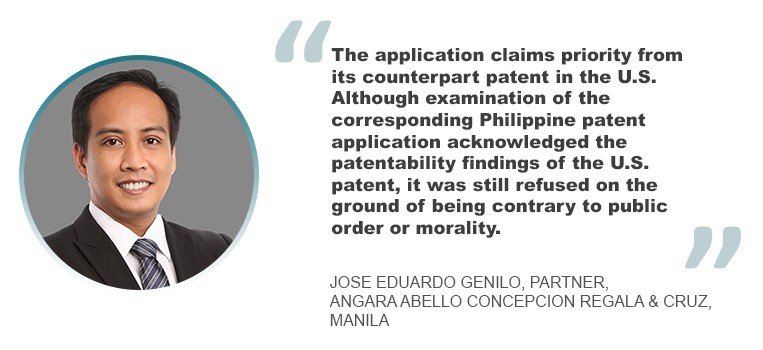Different jurisdictions, different patentability standards
31 March 2024

Obtaining patents in different jurisdictions brings about the challenge of working around different patentability standards. Espie Angelica A. de Leon chats with lawyers across the region about ways to ease the difficulties of patenting the same invention in different places.
Just because an invention is easily patented in one jurisdiction doesn’t mean it will be easy to obtain a patent in every jurisdiction, even those located relatively nearby.
Risti Wulansari, a partner at K&K Advocates in Jakarta, has seemingly endless stories of clients from China who obtained patents for their inventions fairly easily in their home country, but who eventually experienced challenges in obtaining a patent in Indonesia for the same invention. The Southeast Asian nation, as the Chinese clients would discover, has more stringent patentability requirements.
It is a given that substantive standards for patent registration – namely that the invention or subject matter must be novel, include an inventive step, be industrially applicable, among others – are generally applicable in different jurisdictions, including those in Asia. Several international patent-related treaties and agreements such as the TRIPS Agreement, the Paris Convention and the Paris Cooperation Treaty make this harmonization possible. Hence, it is common for a single invention to have patent registration in different countries.
Yet, there remain contrasting standards of patentability among nations, including in Asia. Against this backdrop, obtaining patents for an invention or technology in more than one country can be challenging.
Inventiveness, simple patents, cannabis, etc.: Examples of varying patentability standards
As mentioned, Indonesia has strict requirements for patentability of an invention. To illustrate, examiners at the Indonesian Patent Office (IPO) would not necessarily concur in full with the examination results issued by IP offices in other jurisdictions should part of the scope of invention deemed allowable by the other patent office is contrary to Indonesian patent law.
Yet, Indonesia can also be lenient. Wulansari explained: “A type of leniency which may be given by the IPO when it comes to fulfilment of patentability would be by virtue of a simple patent. Protection can be granted upon an invention as a simple patent, provided that it is new and industrially applicable. Thus, no assessment upon inventive step will be conducted upon this type of patent.”
“Not all Asian countries recognize such practice,” noted Wulansari’s colleague, Rizka Khairunnisa, an associate at the firm. “Some countries do recognize it as a utility model or petty patent, which may provide a more lenient process compared to simple patent filings in Indonesia, sometimes without requiring a patentability examination to take place.”
“However, there are also countries like Singapore that would only recognize the protection of a patent, a situation which may not be favour the inventor or applicant of a simple patent since it may be challenging for him to demonstrate the inventiveness of his invention in order to obtain exclusive rights thereof in Singapore,” Khairunnisa added.
The Philippines has strict standards for patentability as well, according to Jose Eduardo Genilo, a partner at Angara Abello Concepcion Regala & Cruz in Manila. “Mere failure to comply with the formality requirements or deadlines imposed would already lead to a patent application to be withdrawn or forfeited,” Genilo said. “This is on top of the patent examiner’s recognized discretion to refuse a patent application on substantive grounds following its technical assessment.”
Genilo shared that one instance when a patent has been granted in other jurisdictions but denied in the Philippines is when the invention involves second medical use, which is not allowed under the country’s Cheaper Medicines Act.

A similar instance is the case of PH Application No. 1/2017/500733 titled Cannabis Extracts and Methods of Preparing and Using the Same. “Said application claims priority from its counterpart patent in the U.S. where it was eventually granted. Although examination of the corresponding Philippine patent application acknowledged the patentability findings of the counterpart U.S. patent, it was still refused on the ground of being contrary to public order or morality, one of the statutory exclusions in the IP Code,” said Genilo. Under the Philippines’s Comprehensive Dangerous Drugs Act, cannabis is classified as a dangerous drug, and is thus illegal.
China may also have a strict standard on the use of drugs including cannabis and cannabinoid compounds, which are considered to be contrary to the law or social morality of China.
Xia Zheng, founder and patent attorney at AFD China in Beijing, also cited cases wherein patents were granted in other jurisdictions but were denied in China even after rounds of arguments. “In practice, we have seen cases in which the Chinese examiners cite references similar to those cited against foreign counterpart applications when evaluating inventiveness issues, and their opinions are similar to those of foreign examiners on counterpart foreign applications. [But], we have also met some cases that were granted in other countries but could not be granted in China after rounds of arguments. For some cases, the reason may be that the Chinese examiners find new references, such as Chinese publications, that have not been cited by the foreign examiners,” Zheng said.
Speaking of Singapore, acquiring a patent in the island nation is not as easy as it once was. Previously, the country offered a Supplementary Examination route, enabling a Singapore application to rely on positive examination results from a corresponding recognized international or foreign application. The Supplementary Examination route, however, was discontinued effective January 2020. Thus, applications filed on or after January 1, 2020, must undergo substantive examination by local patent examiners.
Despite this change, Abe Sun, partner and lead of overall patents practice for APAC at Baker McKenzie, believes the country isn’t being overly strict. “Based on our experience, we believe the standards for patentability in Singapore are balanced,” he opined, “neither excessively strict nor overly lenient.”

To give an example of contrasting patentability standards among jurisdictions, Sun mentioned the substantive requirement of novelty. Generally, it requires that, subject to certain jurisdiction-specific exemptions, an invention must not have been publicly disclosed before the patent application was filed. Some countries, including Singapore, Malaysia and Thailand, to name a few from Asia, provide exemptions or grace periods for certain public disclosures made prior to filing. “However, relying on such grace periods for public disclosures can be dangerous as such grace periods may not be available in all of your jurisdictions of interest,” Sun warned.
Citing another example, Sun added that certain jurisdictions are stricter than others in terms of how claims can be amended during substantive examination. Some countries such, as Singapore and Malaysia, may not necessarily require literal support in the patent specification for claim amendments. But, others, like Thailand and China, are stricter in terms of requiring literal support in the patent specification.
Meanwhile, in Pakistan, the requirements for patentability are also neither strict nor very lenient, according to Hasan Irfan Khan, an attorney at United Trademark & Patent Services in Lahore. He said: “The standards for patentability of an invention in Pakistan are the same as in most countries of the world, namely that products, processes, formulations, new crystalline forms, etc., are patentable in Pakistan. We believe that the standards in Pakistan are neither strict nor very lenient. If the patentability requirements are fulfilled by an applicant, the Pakistani Patent Office would generally grant a patent and will not raise unreasonable requirements or objections.”
“The different standards for patentability would surely affect a business enterprise’s chances of acquiring a patent,” said Wulansari, “especially noting that some countries are more in favour of their local applicants by providing a certain level of leniency in examination with a spirit of increasing the number of domestic filings.”
This then becomes problematic for the individual or company seeking patent protection. In the absence of a patent in a particular country, the individual or company will find it difficult to prove ownership of its technology or invention in that particular market, even if said technology is widely known in that market to be owned by that particular company or individual.

In other words, this shall mean that having no patent protection in a certain country would likely weaken the position of business enterprises in enforcing their rights. The company may attempt to invalidate another party’s patent based on the prior existence of the invention. However, this does not necessarily mean the company has the right to prohibit the party from using the invention.
“This kind of situation was previously encountered by a U.S.-based company known to be a manufacturer of a certain type of cable. Since it does not have any patent registration over this cable type, the company has no enforceable rights in Indonesia to forbid a local company from producing the same cable type and claim for damages upon it, even though the cable type is highly associated with the U.S. company,” shared Khairunnisa.
“The law laid down by the courts is that even if a product is manufactured legitimately in a foreign country, its import into Pakistan would infringe a Pakistani patent and its import and sale in the Pakistani market can be prevented by an injunction,” Khan added.
Because of varying standards of patentability, individuals and business enterprises applying for patents in multiple jurisdictions should proceed cautiously, like they’re walking on eggshells.
Hurdling the different requirements for patentability
Differences in patentability standards across Asia and beyond does present some hurdles, but there are several things that individuals or business enterprises can do to expedite the patent application process, acquire protection immediately in as many jurisdictions as possible and then enforce it.

“It is always our recommendation for business enterprises to put all the countries they wish to enter the market on the map first and get to know the nature of patent protection available in those countries prior to pursuing patent filings,” said Wulansari. “This tip may indeed cost them a certain amount of time and money, but we believe it is worth an investment,” she advised, “rather than have to deal with challenges after the launch of a product or the use of a process in the market.”
Knowing the nature of the registration process in the market which the company plans to enter is important, or else problems may arise. This is what happened to the Chinese clients mentioned by Wulansari.
Among others, companies should be aware of grace period rules before making pre-filing public disclosures. “As a general rule of thumb, it is always recommended to take an approach of not making any public disclosures prior to the filing of your first patent application,” Sun advised.
It is also important to clearly identify the inventive point of the invention in the patent application. Zheng explained: “The underlying basic principles are generally aligned, i.e. the requirement on novelty, inventiveness and industrial applicability. Therefore, we suggest clearly identifying the inventive point of an invention while preparing a patent application and drafting the description to clearly demonstrate such point, for example, through the advantageous effects achieved.”
Companies may also consider and combine various patent types suitable for their IP. In China, for example, there are three types of patents: invention, utility model and design. The utility model’s patentable subject matter should be technical schemes relating to the product’s shape, structure or their combination. As compared to an invention patent, a utility model patent requires a lower level of inventiveness.
Companies wishing to apply for patent protection in multiple countries might also want to take the work-sharing program route. One such programme is the ASEAN Patents Examination Cooperation (ASPEC), the first regional patent examination cooperation program in the ASEAN region. Through ASPEC, member states can share positive search and examination results among themselves. Based on recent statistics, allowance rate for patent applications participating in ASPEC is over 98 percent.
Another work-sharing program is the bilateral Patent Prosecution Highway (PPH), which expedites substantive examination of a patent application in Asia based on positive examination results from another jurisdiction.

For example, the Intellectual Property Office of the Philippines (IPOPHL) is engaged in a PPH with each of the following IP offices: Japan Patent Office, United States Patent & Trademark Office, Korean Intellectual Property Office and European Patent Office. “Business enterprises who have patent applications in any of the foregoing foreign IP offices and wish to apply the same in the Philippines are encouraged to avail of the work-sharing programs that IPOPHL is a part of. Aside from the counterpart Philippine patent application being given priority, the technical findings of the originating IP office are greatly considered,” said Rowen D. Palma, an associate atAngara Abello Concepcion Regala & Cruz Law Offices in Manila.

“Applications that have passed a PPH program may have a good chance to be granted,” Zheng added.
And, as mentioned, several international treaties and agreements such as the Paris Convention, the TRIPS Agreement and the Patent Cooperation Treaty have set minimum standards for patentability of inventions as well as guidelines for prosecution of international patent applications.
Above all, it is advisable for the company to consult a patent professional first before filing for patent protection. By consulting with a patent professional, enterprises will know key information such as whether the desired subject matter is indeed patentable. They will be able to evaluate the possibility and appropriate way of seeking patent protection in a particular jurisdiction. Consultation will also facilitate corresponding planning. Overall, having a resident patent lawyer in the team will not only provide assurance in terms of prosecuting the patent application; but also in terms of maintaining and enforcing the patent in that country if granted.

For Khan, companies aiming to secure patent protection in multiple jurisdictions should just proceed with filing those applications. He explained: “In our opinion, companies operating in different jurisdictions within Asia can navigate the challenge posed by the different patentability standards by still filing patent applications in all the jurisdictions of interest to obtain patent rights to whatever extent provided by each relevant country so that they are able to enforce their rights at least to the extent of the claims of patent rights obtained in any specific country.”
Different jurisdictions, different patentability standards … but many different ways to address these challenges, as well.






